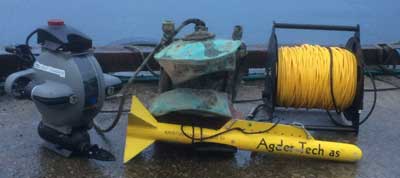DTG2 Helps Locate Sunken WWII German Warship

Deep Trekker Inc. announces that on June 22, 2015 a DTG2 remotely operated vehicle (ROV) was used to help locate the missing Rio de Janeiro, a German warship that sank off of the coast of Norway on April 8th, 1940. The ship was torpedoed by a Polish submarine the day before the Germans invaded Norway during World War II. AGDER-TECH, A-DYKK, and SEABED-SERVICES teamed up for the expedition that took them a total of six years.
Deep Trekker ROVs are underwater inspection tools used for an array of marine exploration projects. Depth rated to 150 meters and capable of withstanding currents of up to two-and-a-half knots, the Deep Trekker ROV was chosen by the expedition team to search for debris laying along to ocean bed that would help indicate the exact location of the Rio de Janeiro.
“The debris was laying as a trail heading to the wreck,” explained Espen Johannson from AGDER-TECH. “Without the Deep Trekker we would have had to use a bigger vessel and work-class ROV. I don’t know of any affordable mini-ROVs that can work in the currents out there.” The Deep Trekker proved to be a worthy tool and the team was able to follow the “map of debris” to the sunken vessel before rigging up a larger ROV to inspect their findings.
The 122 meter long ship was originally a vessel line for passengers and cargo but was used by German forces to transport troops during World War II. Upon being shot down, approximately 180 people survived and another estimated 200 died. On-board the vessel was also a number of horses, ammunitions and animal feed.
The sinking of the ship was an indication of the impending invasion of Norway as many of those saved and who passed away were found wearing German uniforms. Some German officers who were rescued also told local police of their nation’s plans to invade Norway but when the tip was reported to the Norwegian government it was not taken seriously. Consequently, Norway was not prepared when the Germans invaded Bergen on the morning of April 9, 1940. After a short battle the Germans succeeded with their invasion of Norway.
As a significant historical artifact from WW II for Norway, Germany and Poland, the expedition crew made it their mission to locate the missing ship sitting at the bottom of the sea for over 60 years. Initially using a larger ROV, the team required a larger vessel in order to deploy it. That is when they turned to the Deep Trekker ROV to help with their search.
Johannson recounts that the team did not know of any other affordable mini-ROVs that were able to operate in the currents in the area off of Norway where the Rio de Janeiro was located. Deep Trekker DTG2 mini-ROVs are designed differently than traditional ROVs with a spherical shape and patented pitching system, making it easier to maneuver when working in current. Manufactured using dye-cast aluminum that is anodized and powder coated makes the underwater submarines robust tools for an array of undersea inspection expeditions.
The day the team found an old motorcycle sitting on the ocean floor they knew they were close to the Rio de Janeiro. Locating the old German artifact that matched the description of the cargo from the missing warship was a huge feat for the team. The used the Deep Trekker ROV to identify the motorcycle and classify it as a German product that dated back to the WWII era. Since then the three companies have identified the sunken vessel as the Rio de Janeiro. Future plans for the shipwreck are still being decided, but due to the depths and strong currents in the area, it is suspected that the site will remain a historical area to be further researched but not to be used as a recreational dive location.

